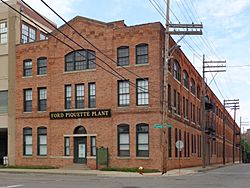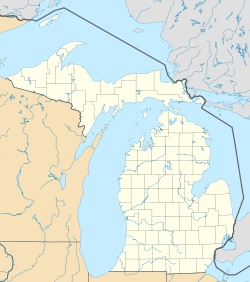Ford Piquette Avenue Plant facts for kids
|
Ford Piquette Avenue Plant
|
|
|
U.S. Historic district
Contributing property |
|

Exterior of the Piquette Avenue Plant
|
|
| Location | 461 Piquette Avenue Detroit, Michigan |
|---|---|
| Built | 1904 |
| Architect | Field, Hinchman & Smith |
| Architectural style | Late Victorian |
| Visitation | 31,018 (2018) |
| Part of | Piquette Avenue Industrial Historic District (ID04000601) |
| NRHP reference No. | 02000041 |
Quick facts for kids Significant dates |
|
| Added to NRHP | 2002 |
| Designated CP | 2004 |
| Designated NHL | 2006 |
The Ford Piquette Avenue Plant is a historic factory in Detroit, Michigan. It was built in 1904 and was the second main place where the Ford Motor Company made cars. This factory is super important because it's where the famous Ford Model T car was first designed and built. The Model T is known for making cars popular for everyone.
Before the Model T, other car models were put together here. Early ideas for a moving assembly line were also tried out at this factory. It was also the first factory to make more than 100 cars in one day! While Ford was at this plant, it became the biggest car maker in the U.S. The company used the factory until 1910, when it moved to a bigger plant.
In 1911, Studebaker bought the factory and used it to build cars until 1933. After that, the building had a few different owners. In 2001, it became a museum. The Piquette Avenue Plant is the oldest car factory building that you can visit. The museum shows how the car industry started in the United States. This building is recognized as a very important historical site.
Contents
History of the Piquette Plant
Ford's Early Years and the New Factory
Henry Ford and some investors started the Ford Motor Company on June 16, 1903. They began making their first car, the original Ford Model A, in a rented shop. The company quickly needed more space. So, on April 10, 1904, they bought land on Piquette Avenue in Detroit.
Construction of the Ford Piquette Avenue Plant began on May 10, 1904. Ford Motor Company moved into its new factory in October of that year.
Designing the Factory
The Piquette Avenue Plant was designed by a Detroit company called Field, Hinchman & Smith. It looks like a late Victorian building and was inspired by old textile mills. Many factories in the U.S. were designed this way back then.
The building has three floors. It is about 56 feet (17 meters) wide and 402 feet (123 meters) long. Its brick walls have 355 windows. The wooden floors cover about 67,000 square feet (6,200 square meters). Henry Ford and the architects made sure the factory had a fire sprinkler system. This was very unusual for factories at that time. Other safety features, like firewalls and fire escapes, are still there today.
Cars Made at Piquette
From October 1904 to the end of 1909, Ford Motor Company made several car models at the Piquette Avenue Plant. These included models B, C, F, K, N, R, S, and T. The first cars made there were the Ford models B and C in late 1904.
Most of the factory work was done by men. However, women put together the parts for the car's ignition system. Workers used hand tools at fixed stations. Car parts were brought by hand to the car's frame for final assembly. Completed cars were shipped by train using a special track behind the building. The number of workers changed often, from 300 to 700 people.
In 1905, Ford Motor Company was the fourth-largest car maker in the U.S. At first, many car parts came from other companies. But by 1908, almost all major parts for Ford cars were made at the Piquette Avenue Plant.
The Model T and Assembly Line Ideas
In January 1907, the design for the Ford Model T began on the third floor of the Piquette Avenue Plant. This car is famous for making cars available to many people. Henry Ford, Joseph Galamb, Childe Harold Wills, and C.J. Smith did much of the design work. The Model T used a special strong and light steel called vanadium steel.
The company showed the Model T plans to its dealers on March 19, 1908. In July 1908, before the Model T was officially released, some workers at the plant tried out a new idea. They experimented with a moving assembly line. This meant the car's frame would move to the workers, who would then add parts. This idea was led by Charles E. Sorensen. He thought a moving assembly line would make building cars faster and easier.
Even without a full moving assembly line, the Piquette Avenue Plant was very efficient. On June 4, 1908, they built 101 cars in one day! This was a record for the car industry at the time.
The very first Model T was finished at the Piquette Avenue Plant on September 27, 1908. People wanted the Model T so much that Ford Motor Company stopped taking orders for two months in 1909. To keep up with demand, Ford moved most of its car production to the new, larger Highland Park Ford Plant by January 1910. The company completely left the Piquette Avenue Plant by October 1910. The idea of a moving assembly line was fully used at the Highland Park plant starting in 1913. Over 15 million Model T's were built in total. The first 14,000 made in the U.S. were assembled at the Piquette Avenue Plant.
| Car model | Image | Engine | Transmission | Lowest sale price | Production period | Notes |
|---|---|---|---|---|---|---|
| Model B |  |
24 horsepower inline 4-cylinder |
2-speed planetary |
$2,000 | Late 1904 – April 1906 |
First Ford car with the engine in the front. Very rare today. |
| Model C |  |
10 horsepower opposed 2-cylinder |
2-speed planetary |
$800 | Late 1904 – December 1905 |
Engine was under the seat. |
| Model F |  |
16 horsepower opposed 2-cylinder |
2-speed planetary |
$1,000 | February 1905 – April 1906 |
Engine was under the seat. |
| Model K |  |
40 horsepower inline 6-cylinder |
2-speed planetary |
$2,500 | Late 1905 – 1908 |
A more expensive car model. |
| Model N |  |
18 horsepower inline 4-cylinder |
2-speed planetary |
$600 | July 1906 – 1908 |
The best-selling car in the U.S. at the time. It was a step before the Model T. |
| Model R |  |
18 horsepower inline 4-cylinder |
2-speed planetary |
$750 | February 1907 – 1908 |
A fancier version of the Model N. |
| Model S |  |
18 horsepower inline 4-cylinder |
2-speed planetary |
$700 | July 1907 – 1908 |
Another fancier version of the Model N. |
| Model T |  |
22 horsepower L-head 4-cylinder |
2-speed planetary |
$825 | September 27, 1908 – December 1909 |
Called the Car of the Century in 1999. |
After Ford: Studebaker and Other Owners
In January 1911, Studebaker bought the Ford Piquette Avenue Plant. Studebaker was a big company that made horse-drawn vehicles. They started putting their name on cars in 1912. Studebaker used the Piquette Avenue Plant to make cars until 1933.
In 1936, Studebaker sold the factory to the Minnesota Mining and Manufacturing Company (3M). This company made rubber car parts. Later, in 1968, the Cadillac Overall Company bought the building. It was then owned by the Heritage Investment Company until 2000. Today, a company called General Linen & Uniform Service uses part of the first floor. The Piquette Avenue Plant is still standing, even though Detroit has changed a lot over the years.
Model T Automotive Heritage Complex (Museum)
The Ford Piquette Avenue Plant was sold to the Model T Automotive Heritage Complex in April 2000. This group is a nonprofit organization that opened the building as a museum on July 27, 2001. It is the oldest car factory building that is open to the public.
The museum is located at 461 Piquette Avenue in Detroit. In 2018, over 31,000 people visited it. The museum has more than 40 old cars made by Ford and other Detroit car makers. You can also see recreated offices, like Henry Ford's office, and the room where the Ford Model T was designed. One of the cars on display is Model T Serial No. 220, which was built at the factory in December 1908. It is one of the oldest Model T cars still around. The museum is usually open from Wednesdays through Sundays.
The Piquette Avenue Plant was added to the National Register of Historic Places in 2002. It became a Michigan State Historic Site in 2003 and a National Historic Landmark in 2006. The front of the factory was fully restored to look like it did in 1904. This was shown to the public on September 27, 2008, which was 100 years after the first Model T was finished.
Around 2016, the National Park Service thought about adding the Piquette Avenue Plant to a list of places that could become World Heritage Sites. However, it was not added because it didn't have enough of its original factory equipment. Also, they suggested that the nomination should include other important Ford sites in Detroit, like the Highland Park Ford Plant.
See also
 In Spanish: Planta Ford de Piquette Avenue para niños
In Spanish: Planta Ford de Piquette Avenue para niños
- Durant-Dort Carriage Company Office
- The Henry Ford
- List of Ford factories
- Michigan Central Station






